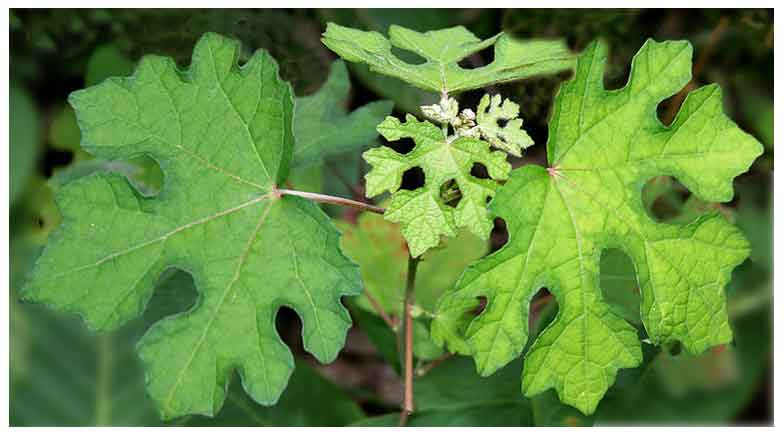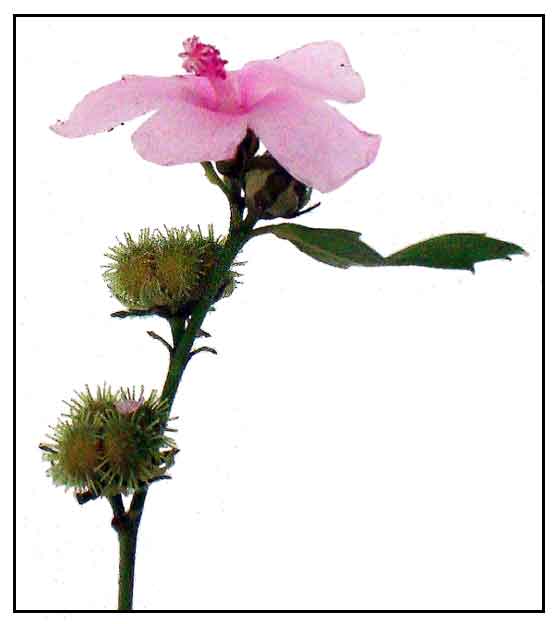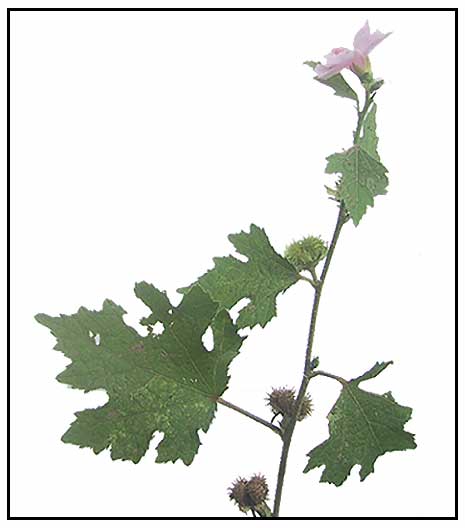|
 Botany Botany
Dalupang erect, branched shrub 0.6 to 2.5 meters high. Plant is exceedingly
variable and more or less hairy, stems often with reddish branches. Leaves are pale beneath, ovate to suborbicular, 3 to 9
centimeters long, heart-shaped at the base, more or less toothed or somewhat
lobed or angled, the lobes not exceeding beyond the middle of
the leaf and the sinuses being usually broad and acute.
Flowers are pink or purplish, about 1.7 millimeters in diameter
and borne singly in the axils of the leaves, or somewhat in panicles.
Petals are 5, free above, connate below and adnate to staminal tube;
staminal tube truncate or minutely toothed, anthers many. Ovary
is 5-celled, branches of stigma 10. Fruits are rounded but flattened and about 7 millimeters in diameter,
with the 5 carpels covered with short, barbed spines.
 Distribution Distribution
- Throughout the Philippines In open places, thickets, etc., at low and medium altitudes,
ascending to 1,600 meters.
- Polymorphous in vegetative characters.
- Pantropic.
Constituents
- Nutrient root analysis yielded carbohydrate 33%, protein 1.9%, fat 1.8%, fiber 51.7%, moisture 6.6%, and ash 5%.
- Preliminary phythochemical analysis of methanol extract of leaves yielded alkaloids, flavonoids, saponins, and tannins. (see study below) (18)
- Study of ethyl acetate portion and n-butanol portion of a 95% ethanol extract of branches and leaves yielded ten flavonoid compounds, viz. kaempferol (1), rutin (2), quercetin (3), afzelin (4), astragalin (5), tiliroside (6), kaempferol-3-O-β-D-glycopyranoside -7-O-α-L-rhamnoside (7), kaempferol-7-O-α-L-rhamnoside (8), kaempferol-7-O-α-L-rhamnoside-4'-O -β-D-glycopyranoside (9) and crenuloside (10).
(24)
- Ethyl acetate fraction of leaves yielded three compounds viz. kaempferol, quercetin, and 3-O-ß-D-(6-O-trans-p-coumaroyl)-α-L-glucopyranosyl-kaempferol (tiliroside). (see study below) (2)
- MS and NMR studies of 95% ethanol extract of branches and leaves of Urena lobata yielded 12 compounds viz. syringic acid (1), glucosyringic acid (2), salicylic acid (3), protocatechuic acid (4), protocatechuic acid methyl ester (5), caffeic acid (6), maleic acid (7), hexatriacontanoic acid (8), pentadecanoic acid (9), hexadecanoic acid (10), heptadecanoic acid (11), diisobutyl phthalate(12). (28)
- Spectroscopic study of extracts of dried powdered leaves
isolated four compounds viz. quercetin, kaempferol, quercetin 3-0-rutinoside and kaempferol 3-0-ß glucopyranoside. (32)
Properties
- Sweet tasting, slightly cooling, mucilaginous.
- Antirheumatic, antipyretic, stomachic, vermifuge.
- Studies have shown antioxidant, antimicrobial, antidiarrheal, wound healing, immunomodulatory, antidiabetic, antihyperlipidemic, antiproliferative properties.
Parts
utilized
· Roots, leaves; preferably fresh.
Uses
Edibility
· In Africa, leaves
and flowers are eaten as famine food.
Folkloric
· In the Philippines, root decoction used to relieve colic.
· Infusion of root used internally as emollient and refrigerant, and externally for skin diseases associated with pain and inflammation.
· Decoction of 30-60 gms of dried roots used for enteritis and
dysentery, rheumatic pains, tonsillitis.
· Boiled and pounded leaves used as poultice for bladder and intestinal inflammations.
· Decoction of roots and leaves used to soften the skin.
· In Tahiti, the plant used as emollient, and the flowers used as expectorant.
· Root used externally for lumbago and rheumatism.
· Decoction of seeds taken internally a vermifuge.
· Poultice of fresh leaves for snake bites, sprains, and bruises.
· Flowers used as expectorant; given for dry and inveterate coughs. Roots used as diuretic; also used externally for rheumatism.
· In Brazil, decoction of stem and root used for severe colic.
 · In Nigeria used to treat diabetes. · In Nigeria used to treat diabetes.
· In Malaysia,
extracts of leaves and roots used to treat abdominal colic, malaria,
gonorrhea, fever, wounds, toothaches and rheumatism.
· In Malaysia,
used for intestinal inflammation and as an emollient.
- In Kenya, the Sabaots of Mt. Elgon chew boiled roots to facilitate to ease delivery of afterbirth. (40)
Livestock
· In the Congo, part of a herbal concoction used for abdominal inflation associated with schistosomiasis, dysentery and diarrhea. For alopecia, skin lesions and dermatoses, rubbed with the ground leaves of Lantana camara on the body.
Others
· Fiber / Paper: Bast fiber of the plant is of the jute type, more easily extracted than jute. Rope made from the fiber is fairly strong. In India, Japan and other countries, it is used as cordage material. It is a favored fiber in the manufacture of coffee bags because it has does not affect the aroma of the coffee. Aramina fiber and Congo jute are produced in Brazil from the Urena
lobata. The fiber also makes a strong paper, and said to be twice as strong as "Bank of England note pulp."
Studies
• Antioxidant: Effects
of Irvingia grandifolia, Urena lobata and Carica papaya on the Oxidative
Status of Normal Rabbits: With recognized therapeutic effects, the plants
were studied for toxic side-effects. Results showed no evidence of oxidative
damage on liver and pancreatic MDA levels on rabbits, and even seemed
to provide protection against lipid peroxidation. (1)
• Phytochemical / Antioxidant /
Antimicrobial: The study of UL leaf extract isolated
3 compounds: kaempferol, quercetin and tiliroside which showed strong
antimicrobial activity against E. coli, Bacillus subtilis and Klebsiella
pneumonia. The study supports the traditional use of the plant for treatment
of infectious diseases. (2)
• Antidiarrheal / Seed Extract: A
study reports the antidiarrheal potential of seed extracts of L dealbata and Urena lobata
used in the traditional medicine by the Naga tribes of India. Both plants
showed significant inhibitory activity against castor oil-induced diarrhea
and PGE2-induced intrafluid accumulation. Both showed significant reduction
in gastrointestinal motility with no signs of toxicity. Results help
explain it traditional use as an antidiarrheal agent. (3)
• Antibacterial: (1) A
study of the methanol extract of UL showed a broad spectrum of antibacterial
activity. (2) Comparative study of methanolic extract of UL root and a standard herbal formulation showed UL has antibacterial activity.
• Immunomodulatory: A
study of the methanolic extract of Urena lobata showed phagocytosis and intracellular killing potency of human neutrophils. Study concludes that U lobata possesses immunomodulatory property. (6)
• Furocoumarin / Imperatorin: Studies have previously yielded mangiferin and quercetin from the aerial parts of the plant. This study isolated imperatorin, a furocoumarin, from the roots. (7)
• Anti-Diabetic / Hypolipidemic: Study of aqueous extracts of Urena lobata (roots and leaves) in STZ-induced diabetic rats showed recognizable hypoglycemic/anti-diabetic and anti-hyperlipidemic effects. (9)
• Hypoglycemic / Long-Term Effects of Root Extract: Study in rabbits showed U. lobata aqueous extract of roots significant reduced body weight and fasting glucose. It exerted an initial toxic effect on hepatocytes and also caused bile obstruction. However, the effects were not severe and not sustained. A reduction in dose, frequency, and duration of administration may reduced the side effects observed in the study. (11)
• Antioxidant / Roots: Study evaluated the methanolic extract of roots of S. retusa, T. rhomboidea, and Urena lobata for antioxidant activity. The extracts were found to inhibit lipid peroxidation scavenge hydroxyl and superoxide radicals in vitro. Results showed all three possessed significant antioxidant activity. (14)
• Antifertility / Spermatogenesis Effect / Roots: Study evaluated E. axillare leaves and Urena lobata roots for antifertility activity in adult male Wistar albino rats. Results showed E. axillare and Urena lobata reversibly inhibited spermatogenesis and steroidogenesis indicating reversible antifertility activity. (15)
• Antioxidant / Cytotoxic / Leaves: Study evaluated a methanolic extract of leaves for antioxidant and cytotoxic potentials. Extract showed potent antioxidant activity with effective scavenging of free radicals and potent cytotoxic activity in the brine shrimp lethality assay. (16)
• Liver Effect / Toxicity Study: Study evaluated the effects of aqueous extract of root on liver of adult Wistar rats. Results show that biochemical and morphological organization of the liver can be significantly altered with continued and increased use of the extract. (17)
• Antihyperglycemic / Antinociceptive / Acute Toxicity Study / Leaves: Study of methanolic extract of leaves showed antihyperglycemic and antinociceptive effects. Alkaloids, flavonoids, saponins and tannins present in the methanolic extract may be responsible for the antinociceptive effect. The extract showed no toxicity when administered to mice at doses up to 3000 mg/kg. (18)
• Sperm Abnormality Effects: In a pilot toxicity study in albino rats, Urena lobata caused a significant increase (p<0.05) in headless tail sperm cell abnormality, a primary sperm abnormality caused by a disruption in the course of spermatogenesis. (19)
• Wound Healing: Study evaluated a methanolic extract for wound healing activity in albino rats. Results showed significant would healing activity in excision, incision, burn, and dead space wound models, comparable to the Povidone-Iodine formulation. (20) Study for wound healing activity by Scratch assay and Fibroblast proliferation assay. Results showed enhanced cell migration on scratch wound assay and increased proliferation of fibroblast proportional to concentration. (27)
• Antidiarrheal / Leaves: Study evaluated the antidiarrheal effects of L. dealbata seed extract and U. lobata leaf extract in castor oil induced diarrhea and PGE2-induced intrafluid accumulation in murine models. Both extracts showed significant reduction in gastrointestinal motility in the charcoal meal test. Acute toxicity tests showed no sign of toxicity in the animals. (21)
• Antiproliferative / Antioxidant: Study of methanol extracts of Urena lobata and Viscum album showed significant antiproliferative and antioxidant properties on MB-MDA435 breast cancer cell line. (22)
• Analytical Potential of Flower Dye Extract: Study showed the flower extract of U. lobata can be used as acid-base indicator in all types of titration, with potential preference over synthetic indicators because of easy availability, inertness, ease of preparation and cost effectiveness. (23)
• Antidiabetic
/ Inhibition of Dipeptidyl Peptidase IV / Leaves: Study evaluated the anti-diabetic potential of leaf extract of U. lobata through dipeptidyl peptidase IV (DPP-IV) inhibitory activity. An ethanolic water extract showed stronger FPP-IV inhibition than water water with an IC50 of 1 654.64 and 6 489.88 µg/mL, respectively. Vildagliptin showed an IC50 of 57.44 µg/mL. In silico analysis of mangiferin, stigmasterol, and ß-stitosterol in U. lobata extract showed strong inhibitory activity on DPP-IV. (26)
• Antioxidant: By DPPH assay, extracts showed remarkable ability to scavenge radicals in a dose dependent manner. Study showed significant inhibition of nitric oxide radical generation by extracts of U. lobata. Percent inhibition by extracts were 75.69% ET, 70.43% HA, 66.20% EA, 64.66% CL, and 60.28% PE, and curcumin at 90.34%. All extracts showed dose dependent response. Activity may be due to the presence of sterols, alkaloids, and flavonoids. (27)
• Analgesic / Membrane Stabilizing: Study evaluated two Bangladeshi plants, Uraria lagopodies and Urena lobata. Oral administration of ethanol extract of U. lobata produced significant (p<0.05) pain relieving activity (decreased number of writhing. Both extracts showed dose-dependent anti-inflammatory and membrane stabilizing activities.
(29)
• Toxicity Study / Spermatogenesis Effects: Pilot toxicity study evaluated three common Nigerian herbs, Hyptis suaveolens, Cleome viscosa and Urena lobata for effects on hematological parameters and sperm count of albino rats. Urena lobata treatment showed significant increase (p<0.05) in neutrophils count of rats. U. lobata showed spermatogenesis effects as evidenced by a significant increase (p<0.05) in headless tail sperm cell abnormality. (30)
• Anxiolytic / Antidepressant / Anti-Inflammatory / Leaves: Study evaluated the anxiolytic (elevated plus maze test, dark light transition model), antidepressant (tail suspension method, forced swim test), and anti-inflammatory effects (carrageenan induced paw edema model) of Urena lobata leaf extract in Swiss albino mice and male Sprague Dawley rats. Results showed the leaf extract could be used for the treatment of anxiety, depression, and inflammation. However, exact mechanisms need further elucidation. (31)
• Leaves as Indicator of Roadside Pollution: Urena lobata leaves growing along busy roadsides in Benin City, Nigeria were evaluated vis-a-vis those growing in forest areas for activity of air pollution. Microscopic observations of leaves from polluted microhabitats showed stomatal pores were plugged at both upper and lower surfaces, which was suspected to be the result of cumulative effects of air pollutants that dominated busy roadside where the plant grows. Leave from non-polluted microhabitats showed no plugging of stomatal pores. Results suggest a potential pointer to negative activity of pollution common in busy roads, especially with regards pollutant contamination of raw and processed food items commonly displayed by food vendors. (33)
• CNS Depressant and Sedative Effects: Study evaluated
a hydro-methanolic fraction for neuropharmacological activities in Swiss mice. Results showed CNS sedative and depressant effects with profound decrease in exploratory activity, marked sedative effect as evidenced by significant reduction in gross behavior and potentiation of pentobarbitone-induced sleeping time. (34)
• Antidiabetic Effect: Study evaluated the antidiabetic effect of hexane, ethanolic, and aqueous leaf extracts of Urena lobata using Sprague Dawley rats. The leaf extracts of three types of solvents all increased serum insulin level and improved ß cell condition, and also decreased the AUC of the OGTT series in diabetic rats. The aqueous leaf extract was best in increasing serum insulin level, recovering islet cell condition, and correlating with blood glucose level. The hexane extract showed poor results. (36)
• Potent Anti-Yeast Triterpenoid Saponin / Clematoside-S / Leaves: Study investigated the antimicrobial activity and isolated an active compound from the leaves of U. lobata. An 80% ethanol extract of leaves yielded an effective anti-yeast activity against Saccharomyces cerevisiae strains. Results suggest a potential application for U. lobata as natural anti-yeast agent in food preservation. (37)
• Wound Healing Activity of Ointment Formulation: Study evaluated the wound healing activity of two different ointment formulations, original extract ointment (EO) and nanotised extract ointment ( NO) using incision and excision models in Swiss albino rats. Skin treated with Nano herbal and extracts ointment revealed epithelisation, thin epidermis, mild to moderate degree of fibrosis. along with neovascularization and mild degree of inflammatory infiltrates in the dermis region. Histopathology findings suggest the nanoherbal extract treated group showed better wound healing as evidenced by fibrosis and reduced inflammatory infiltrates. (38)
• Antihyperglycemic Effect / Inhibition of Dipeptidyl Peptidase IV (DPP-IV) / Leaves: Study evaluated the antidiabetic effect of U. lobata leaf extract through DPP-IV inhibition. Both water and ethanolic extracts from U. lobata decreased DPP-IV level and blood glucose AUC with the water extract showing stronger effect. The extracts significantly increased insulin synthesis of diabetic rats. Active compounds such as mangiferin, stigmasterol and ß-sitosterol have strong inhibitory constants and act as good DPP-IV inhibitors. (39)
Availability
Wild-crafted.
|


![]()

